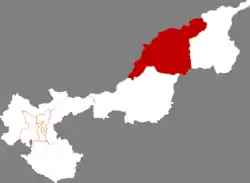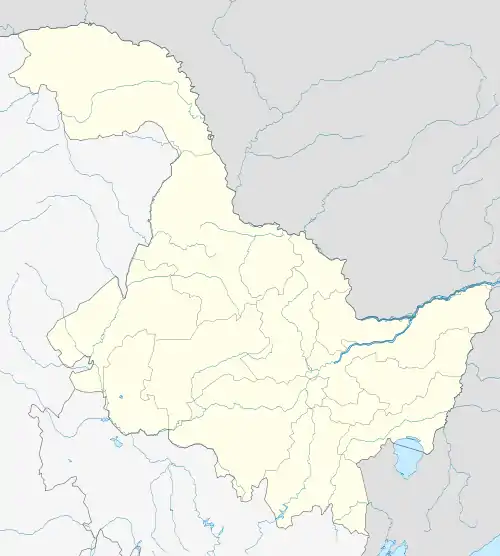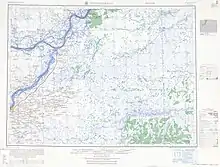Tongjiang, Heilongjiang
Tongjiang (Chinese: 同江; pinyin: Tóngjiāng) is a city of 160,000 in eastern Heilongjiang province, People's Republic of China, located at the confluence and on the right banks of the Songhua and Amur Rivers, the latter which marks the border with Russia. Administratively it is a county-level city of Jiamusi.
Tongjiang
同江市 | |
|---|---|
 Location of Tongjiang in Jiamusi | |
 Tongjiang Location in Heilongjiang | |
| Coordinates: 47°39′N 132°30′E | |
| Country | People's Republic of China |
| Province | Heilongjiang |
| Prefecture-level city | Jiamusi |
| Area | |
| • Total | 6,164 km2 (2,380 sq mi) |
| Population | |
| • Total | 211,609 |
| • Density | 34/km2 (89/sq mi) |
| Time zone | UTC+8 (China Standard) |
| Climate | Dwb |
| Website | tongjiang |
History

Early medieval history
From 698 to 936, the kingdom of Balhae occupied northern Korea and parts of Manchuria and Primorsky Krai, consisting of the Nanai, the Udege, and the Evenks and descendants of the Tungus-speaking people and the people of the recently fallen Goguryeo kingdom of Korea. The vicinity of Tongjiang was settled at this moment by Heishui Mohe tribes (Hangul : 흑수말갈 Hanja/Hanzi : 黑水靺鞨 pinyin : Hēishuǐ Mòhé). These tribes were submitted to Balhae Kingdom under King Seon's reign (818-830).
King Seon administrated their territories by creating a prefecture in the neighbourhood : The Hoiwon Prefecture (Hangul : 회원부 Hanja : 懷遠府) with Dalju (Hangul : 달주 Hanja :達州) present-day Tongjiang (Hanzi :同江 pinyin :Tóngjiāng), as its administrative centre.
20th century
In 1929 during Sino-Soviet conflict soviet Amur Military Flotilla completely destroyed Chinese Sungary Military Flotilia at Battle near Lahasusu.
Tongjiang-Nizhneleninskoye railway bridge
The Tongjiang-Nizhneleninskoye railway bridge was proposed in 2007 by Valery Solomonovich Gurevich, the vice-chairman of the Jewish Autonomous Oblast in Russia. The railway bridge over the Amur River will connect Tongjiang with Nizhneleninskoye, a village in the Jewish Autonomous Oblast.[1]
The Chinese portion of the bridge was finished in July 2016.[2] Work began on the longer Russian section of the bridge in December 2016. Completion of structural link between the two sides of the bridge was completed in March 2019.[3][4] Opening to rail traffic has been repeatedly delayed, with the December 2019 estimate being "the end of 2020",[5] and then 3rd quarter of 2021.[6]
Transportation
See also
References
- Proposed bridge to boost bilateral trade, China Daily, June 19, 2007.
- Andrew Higgins (July 16, 2016). "An Unfinished Bridge, and Partnership, Between Russia and China". The New York Times. Retrieved July 17, 2016.
- "Russia Completes Construction of First-Ever Rail Bridge to China", The Moscow Times, March 21, 2019, retrieved November 16, 2020
- Россия и Китай соединили железнодорожный мост через Амур [Russia and China connected a railway bridge across the Amur] (in Russian), RBK Group, March 21, 2019, retrieved November 16, 2020
- "Railway bridge over Amur river to China will be built by end of 2020, envoy says". TASS. Retrieved November 16, 2020.
- https://www.dvnovosti.ru/eao/2020/02/17/110702/